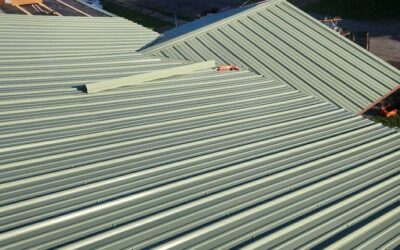What Are Elastomeric Roof Coatings and How Do They Work?
Introduction
Elastomeric roof coatings are a highly effective solution for protecting and extending the lifespan of various roofing systems. These coatings create a seamless, waterproof barrier that enhances durability, energy efficiency, and weather resistance. Whether you have a commercial or residential roof, elastomeric coatings provide an affordable way to improve performance and reduce maintenance costs.
In this guide, we’ll explore what elastomeric roof coatings are, how they work, and the four main types: silicone, polyurethane, acrylic, and butyl.
What Are Elastomeric Roof Coatings?
Elastomeric roof coatings are liquid-applied roofing solutions designed to create a flexible, waterproof membrane over an existing roof. The term “elastomeric” refers to the coating’s ability to stretch and contract in response to temperature fluctuations, preventing cracks and leaks.
These coatings are commonly used on flat and low-slope roofs, though they can also be applied to other roof types to enhance protection and longevity.
Key Features of Elastomeric Roof Coatings:
- Highly Flexible – Expands and contracts with temperature changes.
- Waterproofing Properties – Seals leaks and prevents moisture infiltration.
- UV and Weather Resistance – Protects against sun exposure, wind, and rain.
- Energy Efficiency – Reflects sunlight to reduce cooling costs.
- Compatible with Multiple Roof Types – Suitable for metal, asphalt, concrete, and more.
How Do Elastomeric Roof Coatings Work?
Elastomeric coatings are applied as a liquid that cures into a seamless, rubber-like membrane. This coating fills cracks, gaps, and seams, providing an extra layer of protection against leaks and environmental damage. The application process typically involves:
- Roof Preparation – Cleaning the surface and making necessary repairs.
- Primer Application (if needed) – Enhances adhesion for some roof types.
- Coating Application – Using a roller, sprayer, or brush to apply the coating.
- Curing Process – The coating dries and bonds to the roof surface, forming a flexible and durable barrier.
Benefits of Elastomeric Roof Coatings:
- Extends roof lifespan by 10-20 years.
- Reduces energy costs with reflective properties.
- Minimizes maintenance by sealing cracks and preventing leaks.
- Eco-friendly by reducing the need for full roof replacements.
Types of Elastomeric Roof Coatings
1. Silicone Roof Coatings
Overview
Silicone roof coatings are highly durable and water-resistant, making them an excellent choice for areas with heavy rainfall or extreme weather conditions.
Benefits:
- Superior Waterproofing – Ideal for flat and low-slope roofs prone to ponding water.
- UV Resistance – Does not degrade under prolonged sun exposure.
- Long-Lasting Performance – Can last over 20 years with proper maintenance.
- Low Maintenance – Requires fewer reapplications compared to other coatings.
Best For:
- Commercial and industrial buildings.
- Areas with high humidity and frequent rain.
- Flat roofs with water drainage issues.
2. Polyurethane Roof Coatings
Overview
Polyurethane coatings are known for their impact resistance and durability, making them ideal for roofs exposed to heavy foot traffic or mechanical stress.
Benefits:
- High Durability – Withstands foot traffic and mechanical damage.
- Resistant to Chemicals – Ideal for industrial settings with chemical exposure.
- Waterproof & Flexible – Adapts to temperature changes without cracking.
Best For:
- Commercial buildings with high foot traffic on the roof.
- Warehouses and industrial facilities.
- Metal and concrete roofs requiring impact resistance.
3. Acrylic Roof Coatings
Overview
Acrylic coatings are water-based and offer excellent UV protection, making them a cost-effective choice for energy-efficient roofing solutions.
Benefits:
- Highly Reflective – Reduces heat absorption and lowers cooling costs.
- Environmentally Friendly – Low VOC and water-based formula.
- Easy to Apply – Can be sprayed or rolled onto most roof surfaces.
Best For:
- Homes and buildings in hot, sunny climates.
- Low-cost roofing solutions.
- Sloped roofs where water drainage is efficient.
4. Butyl Roof Coatings
Overview
Butyl coatings offer strong adhesion and water resistance, making them suitable for roofs with frequent exposure to extreme weather.
Benefits:
- Excellent Adhesion – Bonds well to a variety of surfaces.
- Superior Waterproofing – Ideal for preventing leaks and moisture damage.
- High Elasticity – Expands and contracts without cracking.
Best For:
- Buildings in regions with heavy rainfall or temperature fluctuations.
- Roofs requiring strong adhesion due to challenging conditions.
- Metal, single-ply, and spray foam roofing systems.
How to Choose the Right Elastomeric Roof Coating
Key Factors to Consider:
- Climate – Choose a coating that suits your weather conditions.
- Roof Type – Ensure compatibility with your existing roof material.
- Durability Needs – Consider impact resistance if your roof experiences foot traffic.
- Budget – Factor in initial costs and long-term maintenance savings.
- Application Method – Some coatings require professional application, while others are DIY-friendly.
Conclusion
Elastomeric roof coatings offer an affordable and effective way to enhance roof performance, improve energy efficiency, and extend the lifespan of various roofing systems. Whether you choose silicone, polyurethane, acrylic, or butyl, each coating has unique benefits that cater to different needs.
If you’re considering an elastomeric roof coating for your home or commercial property, S&K Construction and Remodeling LLC can help you select and apply the best solution. Contact us today for professional roofing services and expert guidance!
 (440) 307-2060
(440) 307-2060

